The 2018 tariff hikes reversed a decades-long push by the US for lower global trade barriers around the world. This column examines the impact of the resulting trade war on the US economy. It estimates a $68.8 billion annual loss to US consumers and firms from higher import prices, with an aggregate annual loss of $7.8 billion when producer gains and tariff revenues are factored in. It also argues that US tariffs protected politically competitive counties, whereas retaliations by other nations targeted strongly Republican counties.
For decades, the US pushed for lower global trade barriers around the world. These efforts were reversed in 2018 when the US implemented tariffs on 12.6% of its imports, raising tariffs on targeted imports from an average 2.6% to 17%. Trade partners retaliated by targeting 6.2% of US exports, raising tariffs from average 6.6% to 23%. This episode is the largest return to protectionism by the US since the 1930 Smoot-Hawley Act and the 1971 ‘Nixon shock’ (Irwin 1998, 2013).
In a recent paper (Fajgelbaum et al. 2019), we estimate the impact of the trade war on the US economy. Our main findings are:
- large and immediate impacts of tariffs on trade flows;
- complete pass-through of US tariffs to variety-level import prices;
- a $68.8 billion annual loss to US consumers and firms from higher import prices;
- a $7.8 billion annual aggregate loss when producer gains and tariff revenue are factored in;
- US tariffs protected politically competitive counties, whereas retaliations targeted heavily Republican counties; and
- on net, Republican counties are most negatively impacted by the trade war.
Import and export volumes and pass-through
We use an event-study design on monthly US import data to document differential impacts on targeted imported and exported varieties relative to non-targeted varieties (varieties are defined as 10-digit product-country pairs). Documenting the absence of pre-trends is crucial for using the tariffs from the trade war as a source of identifying variation. Additionally, the event study analysis tests for anticipatory effects.
The event study in Figure 1 reveals four messages. First, prior to the trade war, targeted varieties were not on different trends. Second, anticipatory effects are quantitatively very small, implying that importers did not shift purchases forward (Note 1). Third, we detect large and immediate impacts of tariffs: import volumes fall by 30%. Finally, we see complete pass-through of tariffs to tariff-inclusive prices (i.e. before-tariff prices do not fall), implying that the costs of US tariffs are paid by US importers (Note 2). This complete pass-through result is confirmed by Amiti et al. (2019).
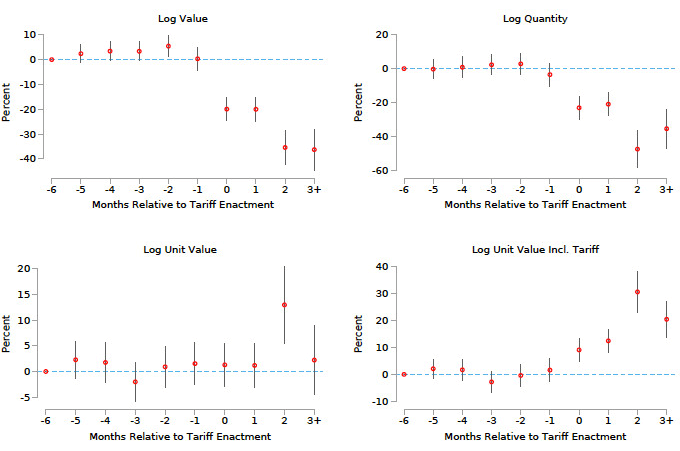
We implement an analogous event study for US exports that examines the impacts of the retaliatory tariffs (Figure 2). The figure reveals that targeted US export varieties were not on differential trends, and no evidence of anticipatory behaviour. Upon implementation of the retaliatory tariffs, US exports fall sharply. We do not observe US exporters lowering before-tariff unit values to retaliating countries relative to other countries.
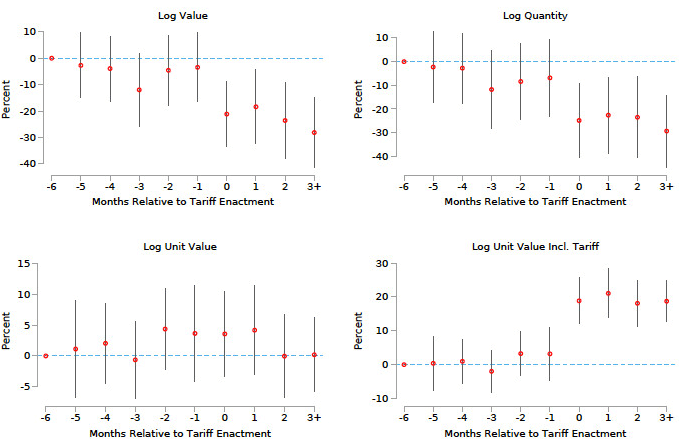
Aggregate impacts
The aggregate and distributional consequences of the trade war depend on the incidence of the tariffs. While the reduced-form evidence provides guidance, assessing these impacts requires structural elasticities. We make progress on a key methodological issue: if changes in tariffs are uncorrelated with contemporaneous demand and supply shocks – a crucial assumption validated by the event studies and pre-trends checks – a single tariff can be used to simultaneously instrument both the imports demand and foreign export supply curves (Zoutman et al. 2018).
Using this approach, we obtain variety-level import demand and export supply elasticities. We also obtain demand elasticities between imported products, and between imports and domestic goods. According to our estimates, we cannot reject a perfectly horizontal foreign supply curve. We also find a more inelastic foreign import demand than US import demand.
We combine these estimated trade elasticities with a supply-side model of the US that shares features with Caliendo et al. (2017). The model includes input-output linkages across sectors, heterogeneity in specialization patterns across US counties, sector-specific factors, and imperfect regional mobility. We match the model to pre-war data on economic activity across US counties, 4-digit industries, and variety-level trade. The magnitudes of the aggregate and regional effects depend on both the estimated trade elasticities and on the sector-level supply elasticities implied by this framework.
The results of our counterfactuals are summarised in Table 1. We calculate annual losses to US importers (consumers and firms) at $68.8 billion (0.37% of GDP). After accounting for tariff revenue received by the government and gains to domestic producers, the welfare loss is only $7.8 billion (0.04% of GDP). In a counterfactual where we assume no retaliation by US trade partners, we find larger producer gains and a negligible aggregate welfare loss (only one-third as large as in the full war).
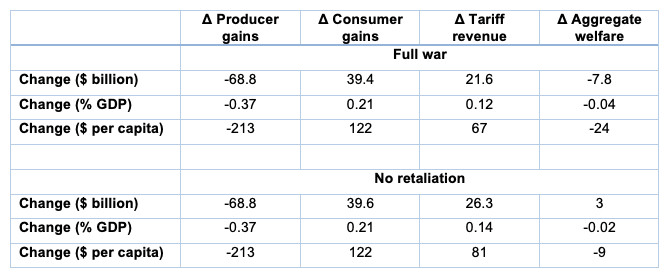
To illustrate the intuition underlying these results, consider the consequences of US tariffs on appliance imports. The price of US appliances is determined by the intersection between US supply and world demand (from both the US and foreign countries). US and foreign tariffs affect this price by shifting world demand.
The US experiences a terms-of-trade gain if the price of exported products increases relative to the price of the imported products.
When the US imposes a tariff on a particular appliance from some origin (such as Korean washing machines) there is a one-to-one impact on the price paid by consumers (our complete pass-through result), leading to welfare losses by consumers and tariff revenue for the government.
In addition, US consumers respond by purchasing more domestically produced appliances. Because sector-level production of appliances is not perfectly elastic (as is reasonable to assume in the short run), this reallocation raises the price of US made appliances, including those that are exported to world markets. Hence, there is a positive terms-of-trade effect, leading to the producer gains we estimate. This model-based result is consistent the empirical finding that sector-level US import tariffs indeed led to increases in the sector-level US producer price index, with an elasticity of 0.13 (standard error = 0.06). By the same logic, when a foreign country retaliates on US appliances, world demand for US appliances falls, reducing the gains to US producers.
Regional consequences, structure of protection, and electoral incentives
The small aggregate effects mask heterogeneous impacts across regions.
Figure 3 shows that import tariffs provided the most protection to sectors such as steel and appliances that tend to be geographically concentrated in Rust Belt states like Michigan, Ohio, and Pennsylvania. By contrast, foreign countries targeted their retaliations on agriculture sectors primarily located in Midwestern and Mountain states such as Iowa, Kansas, Idaho, and North and South Dakota (Figure 4).
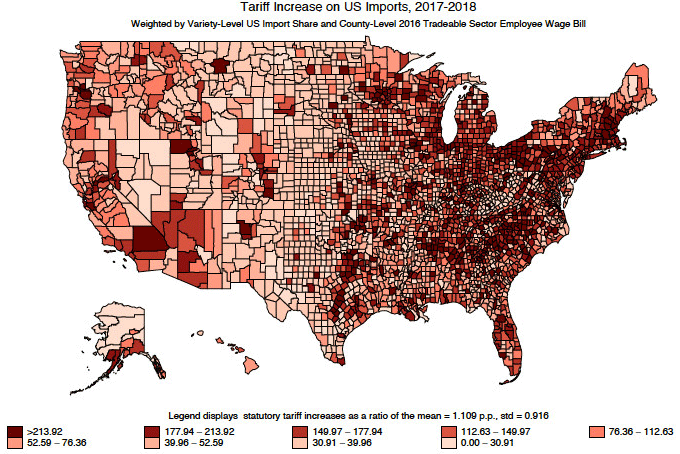
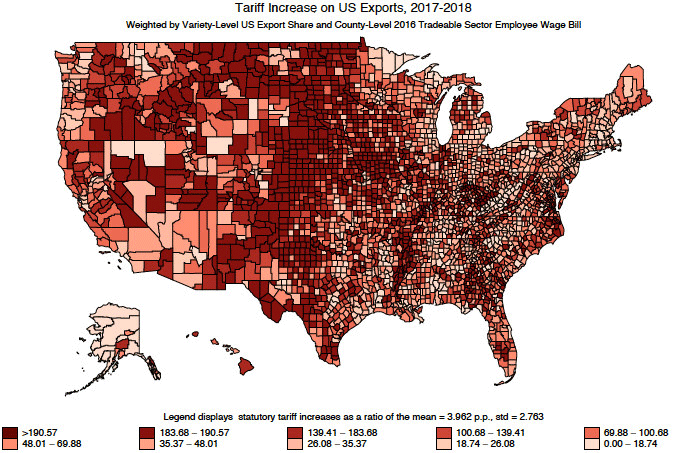
If workers are regionally immobile, this regional heterogeneity generates distributional impacts. Using the model, we compute a standard deviation of real wages in the tradeable sectors across counties of 0.4%, relative to an average real wage decrease of 0.7%.
Why did the US target some sectors for import protection but not others? We probe the hypothesis that the structure of protection was motivated by electoral incentives. Figure 5 plots changes in import tariff exposure against the 2016 GOP presidential vote share at the county level. The figure provides suggestive evidence that the US tariffs may have aimed to protect electorally competitive counties with a 40-60% GOP vote share. Foreign countries, on the other hand, targeted rural, agriculture counties that voted strongly in favour of the GOP in 2016.
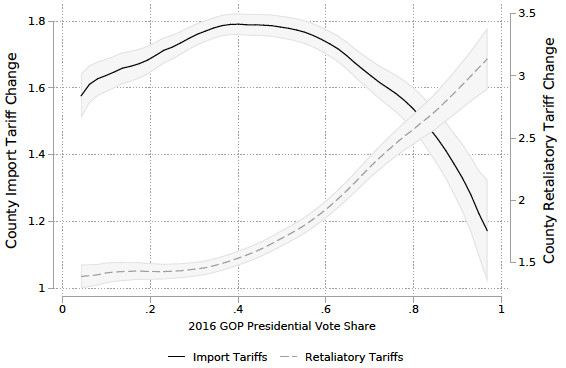
As a result of these retaliations, we compute that strongly Republican counties are hit hardest by the trade war. As shown in Figure 6, relative to a heavily Democratic county (with a 5-15% GOP vote share), the welfare losses in a heavily Republican county (with a 85-95% GOP vote share) are 33% larger.
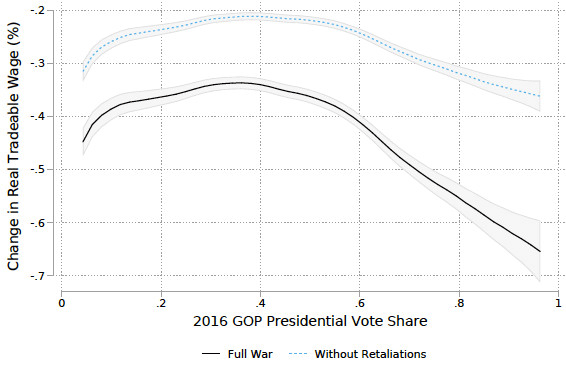
Concluding remarks
Our research has aimed to help scholars and policymakers understand the short-run effects of the trade war on the US economy. Our analysis does not consider the impacts of the trade war on economic uncertainty, productivity and innovation, or long-run economic outcomes. Future research in these areas would provide a valuable complement to this study and to ongoing debates about optimal trade policy.
This article first appeared on www.VoxEU.org on April 12, 2019. Reproduced with permission.





